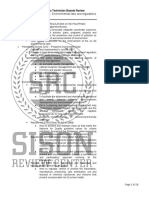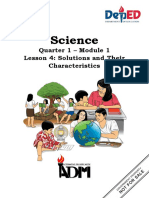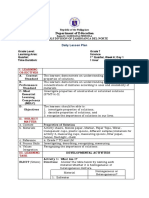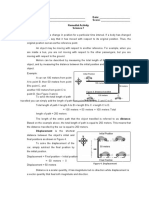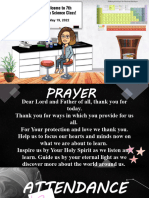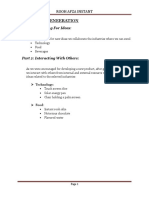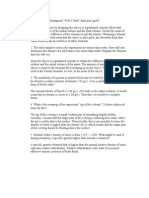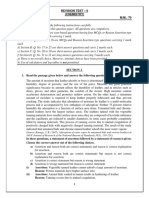0 ratings0% found this document useful (0 votes)
325 viewsNatural Resources
Natural Resources
Uploaded by
sana ali huabishiThis document defines and classifies various types of natural resources. It discusses renewable resources like forests, wind, sunlight, and water which can regenerate. It also discusses non-renewable resources like fossil fuels and minerals which cannot be replenished. For each resource, it provides details on what creates it, where it can be found, whether it is renewable, and how it can be used as an energy source as well as advantages and disadvantages. It also discusses the concepts of renewability, exhaustibility, conservation, and preservation as they relate to sustainable use of natural resources.
Copyright:
Attribution Non-Commercial (BY-NC)
Available Formats
Download as PPTX, PDF, TXT or read online from Scribd
Natural Resources
Natural Resources
Uploaded by
sana ali huabishi0 ratings0% found this document useful (0 votes)
325 views20 pagesThis document defines and classifies various types of natural resources. It discusses renewable resources like forests, wind, sunlight, and water which can regenerate. It also discusses non-renewable resources like fossil fuels and minerals which cannot be replenished. For each resource, it provides details on what creates it, where it can be found, whether it is renewable, and how it can be used as an energy source as well as advantages and disadvantages. It also discusses the concepts of renewability, exhaustibility, conservation, and preservation as they relate to sustainable use of natural resources.
Original Description:
natural resourses and there types
Original Title
natural resources
Copyright
© Attribution Non-Commercial (BY-NC)
Available Formats
PPTX, PDF, TXT or read online from Scribd
Share this document
Did you find this document useful?
Is this content inappropriate?
This document defines and classifies various types of natural resources. It discusses renewable resources like forests, wind, sunlight, and water which can regenerate. It also discusses non-renewable resources like fossil fuels and minerals which cannot be replenished. For each resource, it provides details on what creates it, where it can be found, whether it is renewable, and how it can be used as an energy source as well as advantages and disadvantages. It also discusses the concepts of renewability, exhaustibility, conservation, and preservation as they relate to sustainable use of natural resources.
Copyright:
Attribution Non-Commercial (BY-NC)
Available Formats
Download as PPTX, PDF, TXT or read online from Scribd
Download as pptx, pdf, or txt
0 ratings0% found this document useful (0 votes)
325 views20 pagesNatural Resources
Natural Resources
Uploaded by
sana ali huabishiThis document defines and classifies various types of natural resources. It discusses renewable resources like forests, wind, sunlight, and water which can regenerate. It also discusses non-renewable resources like fossil fuels and minerals which cannot be replenished. For each resource, it provides details on what creates it, where it can be found, whether it is renewable, and how it can be used as an energy source as well as advantages and disadvantages. It also discusses the concepts of renewability, exhaustibility, conservation, and preservation as they relate to sustainable use of natural resources.
Copyright:
Attribution Non-Commercial (BY-NC)
Available Formats
Download as PPTX, PDF, TXT or read online from Scribd
Download as pptx, pdf, or txt
You are on page 1of 20
At a glance
Powered by AI
The key takeaways are that natural resources can be classified into renewable and nonrenewable resources based on whether they can be replenished or not. Some of the main types of natural resources discussed are forests, wind, soil, water, minerals, fossil fuels and sunlight.
The different types of natural resources discussed are forests, wind, soil, water, minerals, fossil fuels and sunlight. These were classified into seven groups: forests, wind, soil, water, minerals, fossil fuels and sunlight.
Forests can be used as an energy source by burning wood for fuel. Wind can be used to power windmills which then turn turbines to generate electricity.
NATURAL RESOURCES
DEFINITION
Natural resources are naturally occurring
resources in the environment that have not
been disturbed by mankind. By resource is
meant any physical entity, which has limited
availability. These resources occur in their
natural form.
Kinds of natural resources
Natural Resources can be classified into seven
Groups
1. Forest
2. Wind
3. Soil
4. Water
5. Minerals
6. Fossil Fuels
7. Sunlight
FOREST
A forest is any area with a lot of
trees. There are forests all over the
world. The type of forest varies
depending on the location of the
forest: for example, there are
tropical rain forests, coniferous
forests, and deciduous forests.
FOREST as energy resources
1. Are forests a renewable resource?
Yes, if they are carefully replanted and
allowed to grow. If it is cut down faster
than it can grow, then it is not renewable.
2. How can forests be used as an energy
source?
The wood can be burned for fuel.
3. In what ways are forests a good source
of energy?
It can be renewable.
4. What are the disadvantages to using
forests as a source of energy?
It pollutes; cutting down trees takes away
animal homes and affects the oxygen in
the world.
5. How do you use the resource of forests
in your life, if at all?
Answers will vary.
WIND
Wind is caused by the uneven
heating of the atmosphere. Some
areas of the world, such as costal
regions, have more wind than
others because the terrain of the
area is relatively flat and has few
obstacles to block the wind from
blowing.
WIND
The wind blows naturally – it is not caused
by human activity, and it cannot be used up.
The power of the wind drives sailboats. It
has been used to power windmills that
grind grain. Windmills can also use the
circular movement of the blades to turn a
turbine. This is increasingly used as a
means of generating electricity.
WIND as energy resources
1. Is wind a renewable resource?
Yes, because it cannot be used up.
2. How can wind be used as an energy source?
Wind can power windmills to power turbines to make
electricity.
3. In what ways is wind a good source of energy?
It doesn’t cause pollution and it is renewable.
4. What are disadvantages to using wind as a
source of energy?
It could hurt some animals and some people think the
windmills are ugly.
FOSSIL FUELS
Fossil fuels take millions of years to form.
They are the product of the fossilized
remains of dead plants and animals that
have been exposed to the heat and
pressure deep within the earth’s crust.
There are many types of fossil fuels, such
as petroleum (gasoline), natural gas, and
coal.
FOSSIL FUELS
as energy resources
1. What creates or causes fossil fuels?
Fossil fuels are the product of the fossilized remains of dead plants
and animals that have been exposed to the heat and pressure.
2. Where can fossil fuels be found?
They are found deep within the earth’s crust.
3. Are fossil fuels a renewable resource?
No. Theoretically they are, but as they take so long to form they
cannot possibly be replaced at the rate they are consumed.
4. How can fossil fuels be used as an energy
source?
They are burned to create energy.
5. In what ways are fossil fuels a good source of energy?
They are currently producing 86% of the world’s energy.
6. What are the disadvantages to using fossil fuels as a source of
energy?
They pollute, they are not renewable.
SUN LIGHT
The sun is the closest star to Earth. It brings heat
and light to the world. Some areas of the world,
such as those closest to the equator, have more
sun than others.
The sun’s rays are used for energy by organisms that
undergo photosynthesis. Nearly every organism on
the planet gets energy through photosynthesis,
directly or indirectly. There are also ways that people
can utilize the energy that the sun provides.
SUN LIGHT as energy resources
1. What creates or causes solar energy?
Solar energy comes from the sun.
2. Where can solar energy be found?
It can be found anywhere on Earth, in greater concentration closer to the
equator.
3. Is solar energy a renewable
resource?
Yes, it cannot be used up.
4. How can solar energy be use as an energy source?
It can be used for warmth, for light, and via solar panels to generate
electricity.
5. In what ways is solar energy a good source of energy?
It is renewable, it doesn’t cause pollution.
6. What are the disadvantages to using solar power as a
source of energy?
It doesn’t work at night.
WATER
Water is a chemical substance with the chemical
formula H2O. Its molecule contains one oxygen
and two hydrogen atoms connected by covalent
bonds. Water is a liquid at ambient conditions,
but it often co-exists on Earth with its solid state,
ice, and gaseous state, water vapor or steam.
SOIL
Soil is a natural body consisting of
layers (soil horizons) of mineral
constituents of variable thicknesses,
which differ from the parent
materials in their morphological,
physical, chemical, and mineralogical
characteristics. It is composed of
particles of broken rock that have
been altered by chemical and
environmental processes that include
weathering and erosion.
MINERALS
A mineral is a naturally occurring solid
chemical substance that is formed through
geological processes and that has a
characteristic chemical composition, a highly
ordered atomic structure, and specific
physical properties. By comparison, a rock is
an aggregate of minerals and/or mineraloids
and does not have a specific chemical
composition.
Renewability
• RENEWABILITY is whether or not a resource can be restored after it has been used.
• Basis for classifying natural resources:
– Renewable
– Nonrenewable
• RENEWABLE NATURAL RESOURCES can be replaced when used.
– Resource may renew itself and be used again, but renewing may take a long
time
– Examples
• Air
• Soil
• Wildlife
• Plants
• Water
• NONREWABLE NATURAL RESOURCES can not be replaced when used.
– With careful management, some can be reused.
– Examples:
• Minerals (Gold, Silver)
• Fossil Fuels (Oil and Coal)
EXHAUSTIBILITY
• EXHAUSTIBILITY is whether or not the supply of a resource is replenished as it is
used.
• Some resources can be replenished; others cannot be replenished.
INEXHAUSTIBLE NATURAL RESOURCES are resources that are continually being
replenished.
Examples:
Sunlight
Air & Wind
Water
EXHAUSTIBLE NATURAL RESOURCES are resources that are available in limited
quantity that can be used up.
Examples:
Minerals
Fossil Fuels
Soil (replaced so slowly)
CONSERVATION
• CONSERVATION is using resources wisely.
– Resources are not abused, wasted nor destroyed.
– “Wise” is using a resource in ways that do not
diminish its value and assure that supplies will be
available for future generations.
PRESERVATION
• PRESERVATION is maintaining a natural resource without using it up.
1. Do not use plastic bags
2. Do not spit on the ground which is not only unhealthy but also disrespect to
mother earth
3. Join nature clubs and forms one in your school .college and in towns
4. Use summer holidays to prepare a projects on themes related to
sustainable development
5. Plant a tree in your locality or home during monsoon
6. Do not waste paper. Use the blank side printed materials for doing a rough
work.
7. Do not use rivers and streams as dumping ground for waste and garbage
8. Participate on community efforts to clean tanks wells and streams.
Thank You For Your Time
And Attention
You might also like
- SISON REVIEW CENTER: Chemistry Technician Boards Review Chemical Waste Management: 01. Environmental Laws and Regulations in The PhilippinesDocument19 pagesSISON REVIEW CENTER: Chemistry Technician Boards Review Chemical Waste Management: 01. Environmental Laws and Regulations in The PhilippinesJohn Michael TolentinoNo ratings yet
- Color and Intensity of Light in Terms of Its Wave CharacteristicsDocument15 pagesColor and Intensity of Light in Terms of Its Wave CharacteristicsAIREEN RICONo ratings yet
- Natural ResourcesDocument5 pagesNatural Resourcesapi-293431691100% (1)
- MW 35 and MW 36 Wind Sensors - LR PDFDocument4 pagesMW 35 and MW 36 Wind Sensors - LR PDFchristianson_87No ratings yet
- Geotechnical Engineering 1 DiscussionDocument45 pagesGeotechnical Engineering 1 Discussionjl89% (9)
- How Rich Is The Earth?: Grade 7 ScienceDocument60 pagesHow Rich Is The Earth?: Grade 7 ScienceRiza Bustamante AcedoNo ratings yet
- Layers of The AtmosphereDocument19 pagesLayers of The AtmosphereDeevie R. DecioNo ratings yet
- Week 2 The Phil. EnvironmentDocument20 pagesWeek 2 The Phil. EnvironmentCristia Rojas100% (1)
- Science6 - q1 - Mod1les4 - Solutions and Their Characteristics - EDITEDDocument10 pagesScience6 - q1 - Mod1les4 - Solutions and Their Characteristics - EDITEDGene-Beth Cacho GarceNo ratings yet
- Solubility Lesson PlanDocument4 pagesSolubility Lesson PlanLouise Meara SeveroNo ratings yet
- Renewable and Non-RenewableDocument3 pagesRenewable and Non-RenewableJade B. BermasNo ratings yet
- 10G Unit 3 Lessons 7-8Document13 pages10G Unit 3 Lessons 7-8Shehnaz RizviNo ratings yet
- QTR 2 Module 5 InteractionsDocument18 pagesQTR 2 Module 5 InteractionsNick BantoloNo ratings yet
- Periodic TrendsDocument30 pagesPeriodic TrendsMaureen GutierrezNo ratings yet
- Weathering of RockDocument55 pagesWeathering of RockMohamad Khaled NordinNo ratings yet
- Sample Soil WorksheetsDocument12 pagesSample Soil WorksheetsSaravanan Ramasamy100% (1)
- SC 102 Course Outline 1st Sem 2018Document3 pagesSC 102 Course Outline 1st Sem 2018Jocelle Ann RicablancaNo ratings yet
- Mayonnaise Lab ReportDocument2 pagesMayonnaise Lab Reportapi-289060519No ratings yet
- Science 7 w3Document4 pagesScience 7 w3fitz zamoraNo ratings yet
- Percent MassDocument2 pagesPercent MassRonnieMaeMaullionNo ratings yet
- Week 8 Inset DLL Q3 Module 5Document3 pagesWeek 8 Inset DLL Q3 Module 5Michelle Baltazar BazarNo ratings yet
- Group 4 Endogenic and Exogenic ProcessesDocument42 pagesGroup 4 Endogenic and Exogenic ProcessesPrincess PabualanNo ratings yet
- Final Lesson PlanDocument9 pagesFinal Lesson PlanTeodorico LacsonNo ratings yet
- LAS Science7 Q4 MELC 3 Week-3Document7 pagesLAS Science7 Q4 MELC 3 Week-3Amy VillaNo ratings yet
- A Detailed Lesson Plan in Grade 4 DemoDocument7 pagesA Detailed Lesson Plan in Grade 4 DemoCindy Pableo SantosNo ratings yet
- Sarmiento Homes, Muzon, City of San Jose Del Monte, Bulacan: Lesson 1: Saturated and Unsaturated SolutionDocument8 pagesSarmiento Homes, Muzon, City of San Jose Del Monte, Bulacan: Lesson 1: Saturated and Unsaturated SolutionAnna Marie Ledesma UrrutiaNo ratings yet
- Problem SolvingDocument19 pagesProblem SolvingMary Mariette Escalante100% (1)
- A Semi Detailed Lesson Plan in Science 7Document6 pagesA Semi Detailed Lesson Plan in Science 7Kimberly VolfangoNo ratings yet
- LeaP-Science-G7-Week 8-Q3Document4 pagesLeaP-Science-G7-Week 8-Q3CriselAlamagNo ratings yet
- Exercises: Answer 1Document3 pagesExercises: Answer 1Naresh world SinghNo ratings yet
- Edited Detailed Lesson Plan in Science 7Document5 pagesEdited Detailed Lesson Plan in Science 7Krezzle Lyne100% (1)
- SlideDeck-Presentation - Pure-Substances-and-MixturesDocument91 pagesSlideDeck-Presentation - Pure-Substances-and-MixturesNina Angela Cate100% (1)
- Philippine's Natural ResourcesDocument64 pagesPhilippine's Natural ResourcesYay SandovalNo ratings yet
- Mechanical EnergyDocument44 pagesMechanical Energyrichele rectoNo ratings yet
- Ipcrf Sy 2023 2024 - T I IiiDocument3 pagesIpcrf Sy 2023 2024 - T I IiiDan BoragayNo ratings yet
- LANDMASSES AND BODIES OF WATER Simple Detailed Lesson PlanDocument5 pagesLANDMASSES AND BODIES OF WATER Simple Detailed Lesson PlanMonica Grace ManaloNo ratings yet
- Phase ChangeDocument20 pagesPhase ChangeGabrielle EllisNo ratings yet
- ROCKS.1st Quarter.Document48 pagesROCKS.1st Quarter.Nena AbasoloNo ratings yet
- SCIENCE7Q1W6DAY1Document6 pagesSCIENCE7Q1W6DAY1Ann NecdoteNo ratings yet
- Biological OrganizationDocument70 pagesBiological OrganizationSabrina LavegaNo ratings yet
- Ruminant and Pseudo-Ruminant Digestive SystemDocument6 pagesRuminant and Pseudo-Ruminant Digestive SystemCia LabesigNo ratings yet
- DLL Week 7Document4 pagesDLL Week 7Wendz ArominNo ratings yet
- Week 1-2 InterventionDocument7 pagesWeek 1-2 InterventionDiana Marie Mendoza100% (1)
- Scientific (Testable Questions)Document20 pagesScientific (Testable Questions)Hennesy100% (1)
- Quiz Nitrogen CycleDocument1 pageQuiz Nitrogen CycleGrace MagbooNo ratings yet
- Concentration of SolutionDocument5 pagesConcentration of SolutionChrisshalyn Sy PinedaNo ratings yet
- DAILY LESSON LOG Week 3 Science 7Document3 pagesDAILY LESSON LOG Week 3 Science 7Matet GenerosaNo ratings yet
- Science 3 RD Periodical 2 K 19Document12 pagesScience 3 RD Periodical 2 K 19Jack RobertNo ratings yet
- 4th Quarter PPT - Greenhouse Effect & Layers of The AtmosphereDocument76 pages4th Quarter PPT - Greenhouse Effect & Layers of The AtmosphereKaren BasistaNo ratings yet
- Concentration of Solutions - Print - QuizizzDocument5 pagesConcentration of Solutions - Print - QuizizzDarmaine Pajares100% (1)
- Land and Sea Breezes Monsoon Cold and Warm Fronts ItczDocument40 pagesLand and Sea Breezes Monsoon Cold and Warm Fronts ItczJeric ValdezNo ratings yet
- Grade-7 Acid and BaseDocument44 pagesGrade-7 Acid and BaseMira Bagay100% (1)
- A. Human Activities & Stability of EcosystemsDocument7 pagesA. Human Activities & Stability of EcosystemsJames Philip RelleveNo ratings yet
- Budget of Work in Science Vi First QuarterDocument3 pagesBudget of Work in Science Vi First QuarterSonny MatiasNo ratings yet
- Atmosphere DEMODocument24 pagesAtmosphere DEMOJasmine DanaNo ratings yet
- SHLT Sci 7 Q3 WK 1 OkDocument7 pagesSHLT Sci 7 Q3 WK 1 Oknoera angel montemayorNo ratings yet
- Semi Detailed Lesson Plan Grade 7 Heat TransferDocument7 pagesSemi Detailed Lesson Plan Grade 7 Heat Transferjocynt sombilonNo ratings yet
- G7Q4LAS3AW3Document6 pagesG7Q4LAS3AW3Hazel RecañaNo ratings yet
- Grade 7 Earth Science ModuleDocument3 pagesGrade 7 Earth Science ModuleNormaNo ratings yet
- Assignment - 1: What Are Renewable and Non-Renewable Resources?Document16 pagesAssignment - 1: What Are Renewable and Non-Renewable Resources?ᏋᏒ ᎴᏋᏋᎮᏗᏦ ᏦᏬᎷᏗᏒ ᏕᎥᏁᎶᏂNo ratings yet
- Natural Resources: Vital & Invaluable: Subject: Environmental Studies Lecturer: Eng. Ahmad Fawad EhsasDocument42 pagesNatural Resources: Vital & Invaluable: Subject: Environmental Studies Lecturer: Eng. Ahmad Fawad EhsasMohammad Ibrahim AsadNo ratings yet
- Types of Natural ResourcesDocument3 pagesTypes of Natural ResourcesSoumendra RoyNo ratings yet
- Earth's Resources: 6 GradeDocument13 pagesEarth's Resources: 6 GradeJordyn IzenstarkNo ratings yet
- HEWLLETDocument36 pagesHEWLLETsana ali huabishiNo ratings yet
- Uni Lever ReportDocument22 pagesUni Lever Reportsana ali huabishiNo ratings yet
- Step 1:-Idea Geneeration: Rooh Afza InstantDocument19 pagesStep 1:-Idea Geneeration: Rooh Afza Instantsana ali huabishi100% (1)
- LUX Market SummaryDocument10 pagesLUX Market Summarysana ali huabishi100% (3)
- A Theoretical and Practical Guide To The Basics of Designing Air Flow SystemsDocument40 pagesA Theoretical and Practical Guide To The Basics of Designing Air Flow SystemsKagitha Tirumala100% (1)
- Newton's Laws Quiz Review Grade 8 - QuizizzDocument3 pagesNewton's Laws Quiz Review Grade 8 - Quizizzdrhtayhtaywin74No ratings yet
- Remedial Exam 2022-2023Document2 pagesRemedial Exam 2022-2023Rina Romano100% (1)
- 06a PDFDocument27 pages06a PDFGaettan KatambaNo ratings yet
- T-CEET213 Geology For Civil Engineers (Reviewer)Document13 pagesT-CEET213 Geology For Civil Engineers (Reviewer)Kean BognotNo ratings yet
- Question From MoranDocument12 pagesQuestion From MoranandrewjovellanaNo ratings yet
- Chapter 2 Soil-Water-PlantDocument50 pagesChapter 2 Soil-Water-PlantMūssā Mūhābā ZēĒthiopiāNo ratings yet
- Vocabulary Related To Unit4Tthe Environment.Document2 pagesVocabulary Related To Unit4Tthe Environment.Omar Belazri0% (1)
- Life Cycle Cost AnalysisDocument6 pagesLife Cycle Cost AnalysisLepanto SakyodNo ratings yet
- Optimal Sizing and Economical Analysis of PV-WindDocument18 pagesOptimal Sizing and Economical Analysis of PV-WindChaymae MarzoukiNo ratings yet
- Two-Stage Power Decoupling For A Single-Phase Photovoltaic Inverter by Controlling The DC-Link Voltage Ripple in The DQ FrameDocument6 pagesTwo-Stage Power Decoupling For A Single-Phase Photovoltaic Inverter by Controlling The DC-Link Voltage Ripple in The DQ FrameAkbar aliNo ratings yet
- TDP-201 Psychrometrics Level 1 FundamentalsDocument71 pagesTDP-201 Psychrometrics Level 1 FundamentalsErwin Maldo100% (1)
- Us 7347906Document14 pagesUs 7347906Abas NjarkhatirNo ratings yet
- Is Global Warming RealDocument4 pagesIs Global Warming RealshillerNo ratings yet
- Otc 7642 MSDocument8 pagesOtc 7642 MSperiskarasmaNo ratings yet
- Exp 10 Relative Density ApplicationDocument2 pagesExp 10 Relative Density ApplicationLaarni Villalon Ventigan0% (1)
- 1 STAGES of Combustion in CI EngineDocument22 pages1 STAGES of Combustion in CI Engineselvaraj9223No ratings yet
- Spring Break Review Packet 2012Document31 pagesSpring Break Review Packet 2012api-199925868No ratings yet
- Industrial Traning Presentation-1Document25 pagesIndustrial Traning Presentation-1Sumit SabaleNo ratings yet
- Bsme Program of StudyDocument3 pagesBsme Program of StudyIan Joseph DalanginNo ratings yet
- PEARSON Chemistry Chapter 9 Flashcards - QuizletDocument4 pagesPEARSON Chemistry Chapter 9 Flashcards - Quizletأستغفرالله واتوب اليهNo ratings yet
- Hydraulic JumpDocument5 pagesHydraulic Jumpmark_madaNo ratings yet
- Resources, Conservation and Recycling: David A. Turner, Ian D. Williams, Simon KempDocument12 pagesResources, Conservation and Recycling: David A. Turner, Ian D. Williams, Simon KempJay TrambadiaNo ratings yet
- Test 16 Section A: Grammar & Vocabulary (40 Points) I. Choose The Word or Phrase (A, B, C or D) Which Best Completes Each Sentence. (20points)Document17 pagesTest 16 Section A: Grammar & Vocabulary (40 Points) I. Choose The Word or Phrase (A, B, C or D) Which Best Completes Each Sentence. (20points)Vũ Thanh Giang NguyễnNo ratings yet
- Experiment # Experiment #6 6 - Atomic Atomic Spectra SpectraDocument9 pagesExperiment # Experiment #6 6 - Atomic Atomic Spectra SpectraJZ8923No ratings yet
- Revision Test II ChemistryDocument8 pagesRevision Test II ChemistryVaibhavMittalNo ratings yet
- WC91-025 LatinAmDocument94 pagesWC91-025 LatinAmIzac ArturoNo ratings yet
